HND Business Strategy Report: JD Sports Case Study and Analysis
VerifiedAdded on 2023/01/12
|12
|4514
|28
Report
AI Summary
This report provides a comprehensive analysis of JD Sports' business strategy, examining both its macro and internal environments. It begins with an introduction to business strategy and JD Sports' context, highlighting its success and expansion. The report then applies the PESTLE framework to analyze the macro environment, considering political, economic, social, technological, legal, and environmental factors. The internal environment is assessed using the McKinsey 7-S model and TOWS analysis, evaluating strengths, weaknesses, opportunities, and threats. Porter's Five Forces Model is used to evaluate competitive strategies. Finally, the report synthesizes these analyses to produce a strategic management plan, with tangible and tactical strategic priorities and objectives. The report concludes with a summary of the findings and a list of references.
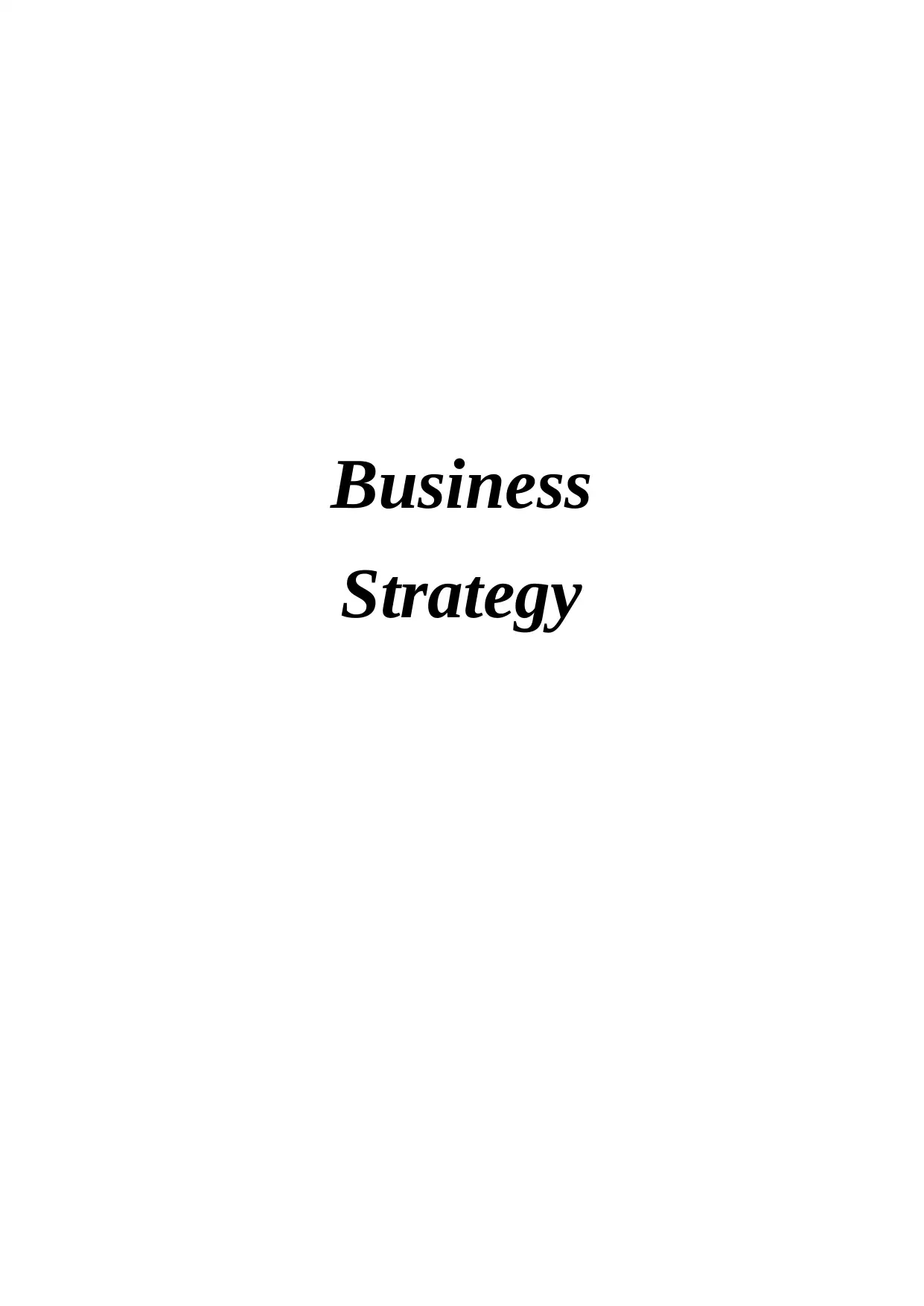
Business
Strategy
Strategy
Paraphrase This Document
Need a fresh take? Get an instant paraphrase of this document with our AI Paraphraser
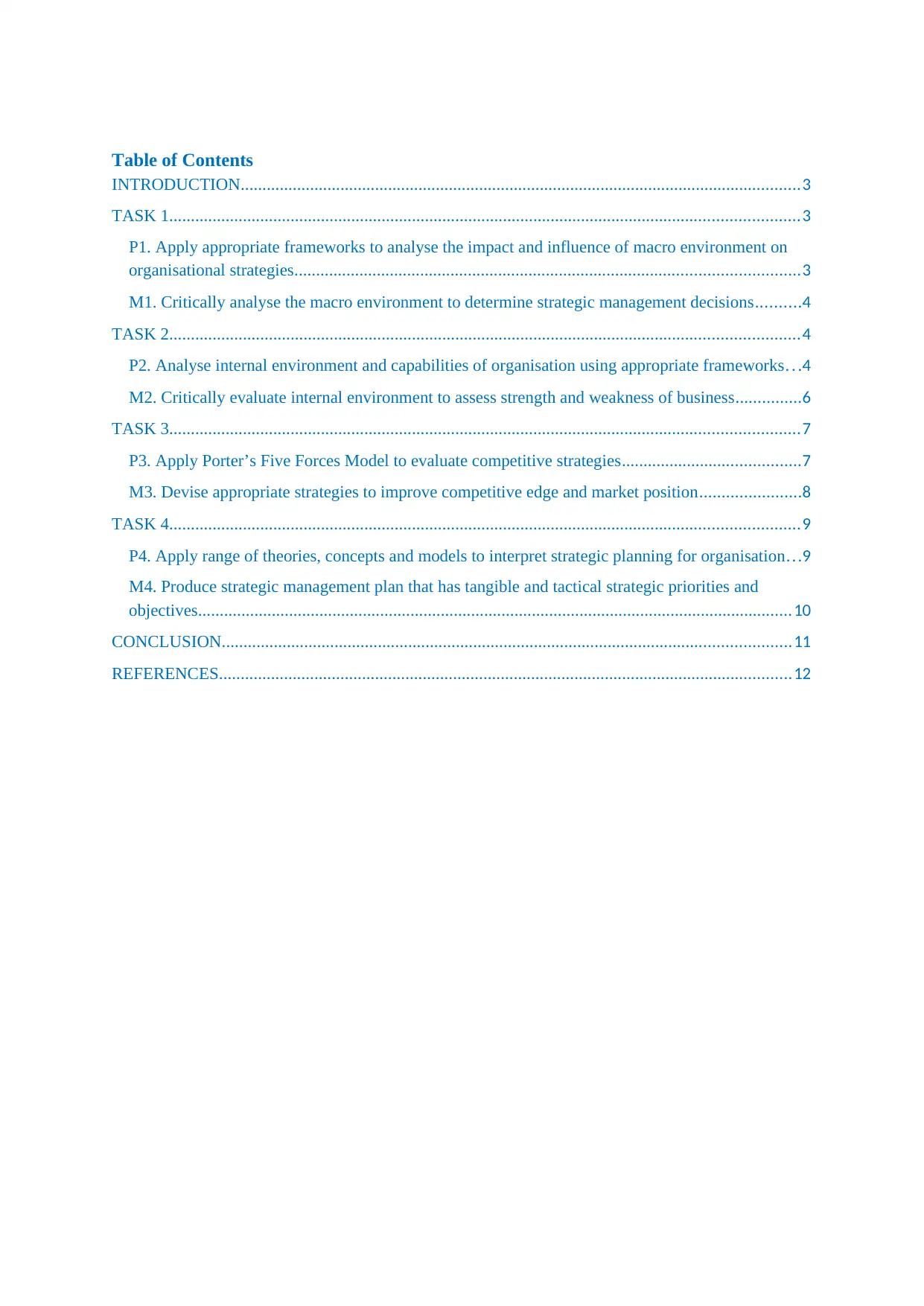
Table of Contents
INTRODUCTION.................................................................................................................................3
TASK 1.................................................................................................................................................3
P1. Apply appropriate frameworks to analyse the impact and influence of macro environment on
organisational strategies....................................................................................................................3
M1. Critically analyse the macro environment to determine strategic management decisions..........4
TASK 2.................................................................................................................................................4
P2. Analyse internal environment and capabilities of organisation using appropriate frameworks. . .4
M2. Critically evaluate internal environment to assess strength and weakness of business...............6
TASK 3.................................................................................................................................................7
P3. Apply Porter’s Five Forces Model to evaluate competitive strategies.........................................7
M3. Devise appropriate strategies to improve competitive edge and market position.......................8
TASK 4.................................................................................................................................................9
P4. Apply range of theories, concepts and models to interpret strategic planning for organisation...9
M4. Produce strategic management plan that has tangible and tactical strategic priorities and
objectives.........................................................................................................................................10
CONCLUSION...................................................................................................................................11
REFERENCES....................................................................................................................................12
INTRODUCTION.................................................................................................................................3
TASK 1.................................................................................................................................................3
P1. Apply appropriate frameworks to analyse the impact and influence of macro environment on
organisational strategies....................................................................................................................3
M1. Critically analyse the macro environment to determine strategic management decisions..........4
TASK 2.................................................................................................................................................4
P2. Analyse internal environment and capabilities of organisation using appropriate frameworks. . .4
M2. Critically evaluate internal environment to assess strength and weakness of business...............6
TASK 3.................................................................................................................................................7
P3. Apply Porter’s Five Forces Model to evaluate competitive strategies.........................................7
M3. Devise appropriate strategies to improve competitive edge and market position.......................8
TASK 4.................................................................................................................................................9
P4. Apply range of theories, concepts and models to interpret strategic planning for organisation...9
M4. Produce strategic management plan that has tangible and tactical strategic priorities and
objectives.........................................................................................................................................10
CONCLUSION...................................................................................................................................11
REFERENCES....................................................................................................................................12
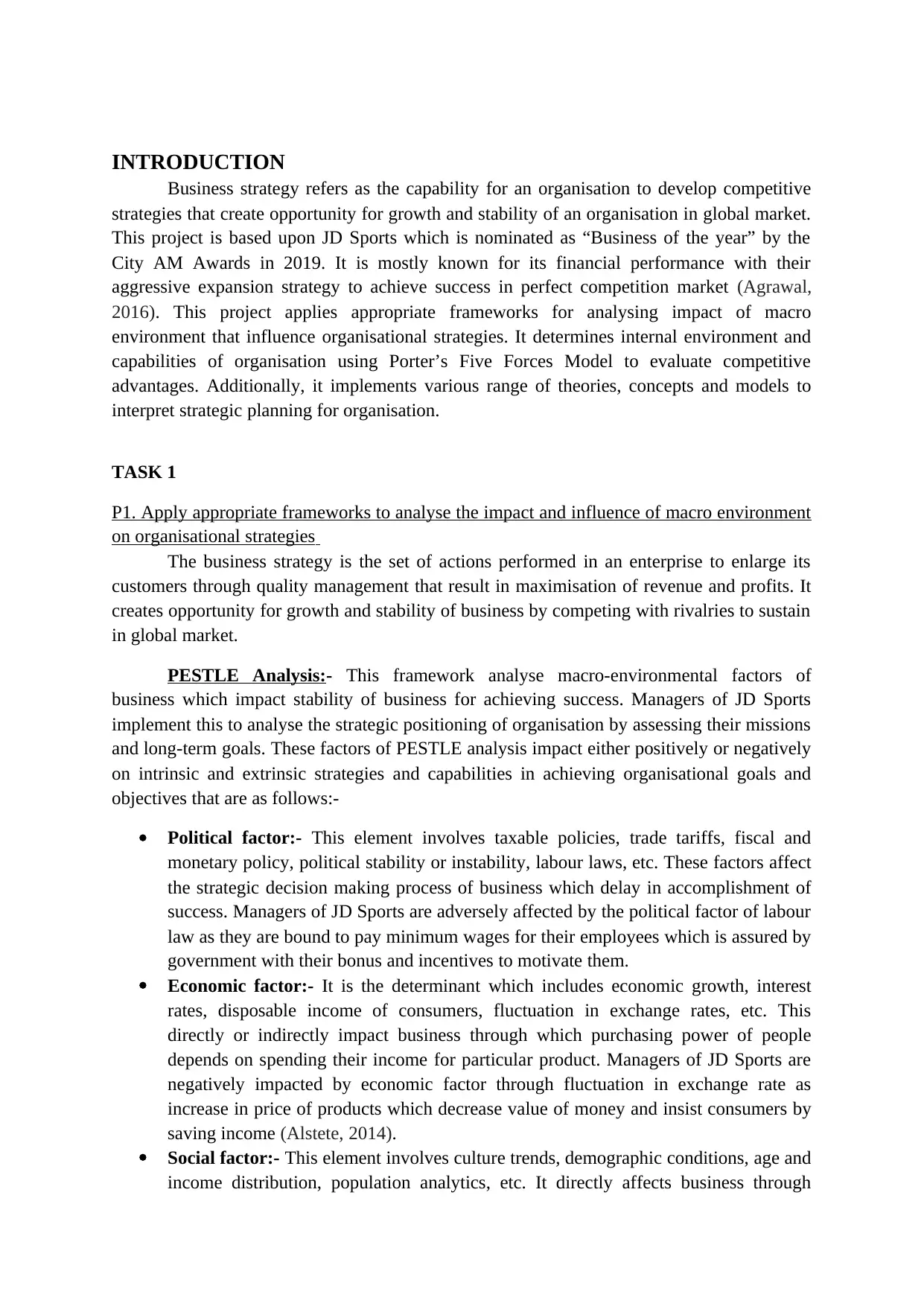
INTRODUCTION
Business strategy refers as the capability for an organisation to develop competitive
strategies that create opportunity for growth and stability of an organisation in global market.
This project is based upon JD Sports which is nominated as “Business of the year” by the
City AM Awards in 2019. It is mostly known for its financial performance with their
aggressive expansion strategy to achieve success in perfect competition market (Agrawal,
2016). This project applies appropriate frameworks for analysing impact of macro
environment that influence organisational strategies. It determines internal environment and
capabilities of organisation using Porter’s Five Forces Model to evaluate competitive
advantages. Additionally, it implements various range of theories, concepts and models to
interpret strategic planning for organisation.
TASK 1
P1. Apply appropriate frameworks to analyse the impact and influence of macro environment
on organisational strategies
The business strategy is the set of actions performed in an enterprise to enlarge its
customers through quality management that result in maximisation of revenue and profits. It
creates opportunity for growth and stability of business by competing with rivalries to sustain
in global market.
PESTLE Analysis:- This framework analyse macro-environmental factors of
business which impact stability of business for achieving success. Managers of JD Sports
implement this to analyse the strategic positioning of organisation by assessing their missions
and long-term goals. These factors of PESTLE analysis impact either positively or negatively
on intrinsic and extrinsic strategies and capabilities in achieving organisational goals and
objectives that are as follows:-
Political factor:- This element involves taxable policies, trade tariffs, fiscal and
monetary policy, political stability or instability, labour laws, etc. These factors affect
the strategic decision making process of business which delay in accomplishment of
success. Managers of JD Sports are adversely affected by the political factor of labour
law as they are bound to pay minimum wages for their employees which is assured by
government with their bonus and incentives to motivate them.
Economic factor:- It is the determinant which includes economic growth, interest
rates, disposable income of consumers, fluctuation in exchange rates, etc. This
directly or indirectly impact business through which purchasing power of people
depends on spending their income for particular product. Managers of JD Sports are
negatively impacted by economic factor through fluctuation in exchange rate as
increase in price of products which decrease value of money and insist consumers by
saving income (Alstete, 2014).
Social factor:- This element involves culture trends, demographic conditions, age and
income distribution, population analytics, etc. It directly affects business through
Business strategy refers as the capability for an organisation to develop competitive
strategies that create opportunity for growth and stability of an organisation in global market.
This project is based upon JD Sports which is nominated as “Business of the year” by the
City AM Awards in 2019. It is mostly known for its financial performance with their
aggressive expansion strategy to achieve success in perfect competition market (Agrawal,
2016). This project applies appropriate frameworks for analysing impact of macro
environment that influence organisational strategies. It determines internal environment and
capabilities of organisation using Porter’s Five Forces Model to evaluate competitive
advantages. Additionally, it implements various range of theories, concepts and models to
interpret strategic planning for organisation.
TASK 1
P1. Apply appropriate frameworks to analyse the impact and influence of macro environment
on organisational strategies
The business strategy is the set of actions performed in an enterprise to enlarge its
customers through quality management that result in maximisation of revenue and profits. It
creates opportunity for growth and stability of business by competing with rivalries to sustain
in global market.
PESTLE Analysis:- This framework analyse macro-environmental factors of
business which impact stability of business for achieving success. Managers of JD Sports
implement this to analyse the strategic positioning of organisation by assessing their missions
and long-term goals. These factors of PESTLE analysis impact either positively or negatively
on intrinsic and extrinsic strategies and capabilities in achieving organisational goals and
objectives that are as follows:-
Political factor:- This element involves taxable policies, trade tariffs, fiscal and
monetary policy, political stability or instability, labour laws, etc. These factors affect
the strategic decision making process of business which delay in accomplishment of
success. Managers of JD Sports are adversely affected by the political factor of labour
law as they are bound to pay minimum wages for their employees which is assured by
government with their bonus and incentives to motivate them.
Economic factor:- It is the determinant which includes economic growth, interest
rates, disposable income of consumers, fluctuation in exchange rates, etc. This
directly or indirectly impact business through which purchasing power of people
depends on spending their income for particular product. Managers of JD Sports are
negatively impacted by economic factor through fluctuation in exchange rate as
increase in price of products which decrease value of money and insist consumers by
saving income (Alstete, 2014).
Social factor:- This element involves culture trends, demographic conditions, age and
income distribution, population analytics, etc. It directly affects business through
⊘ This is a preview!⊘
Do you want full access?
Subscribe today to unlock all pages.

Trusted by 1+ million students worldwide
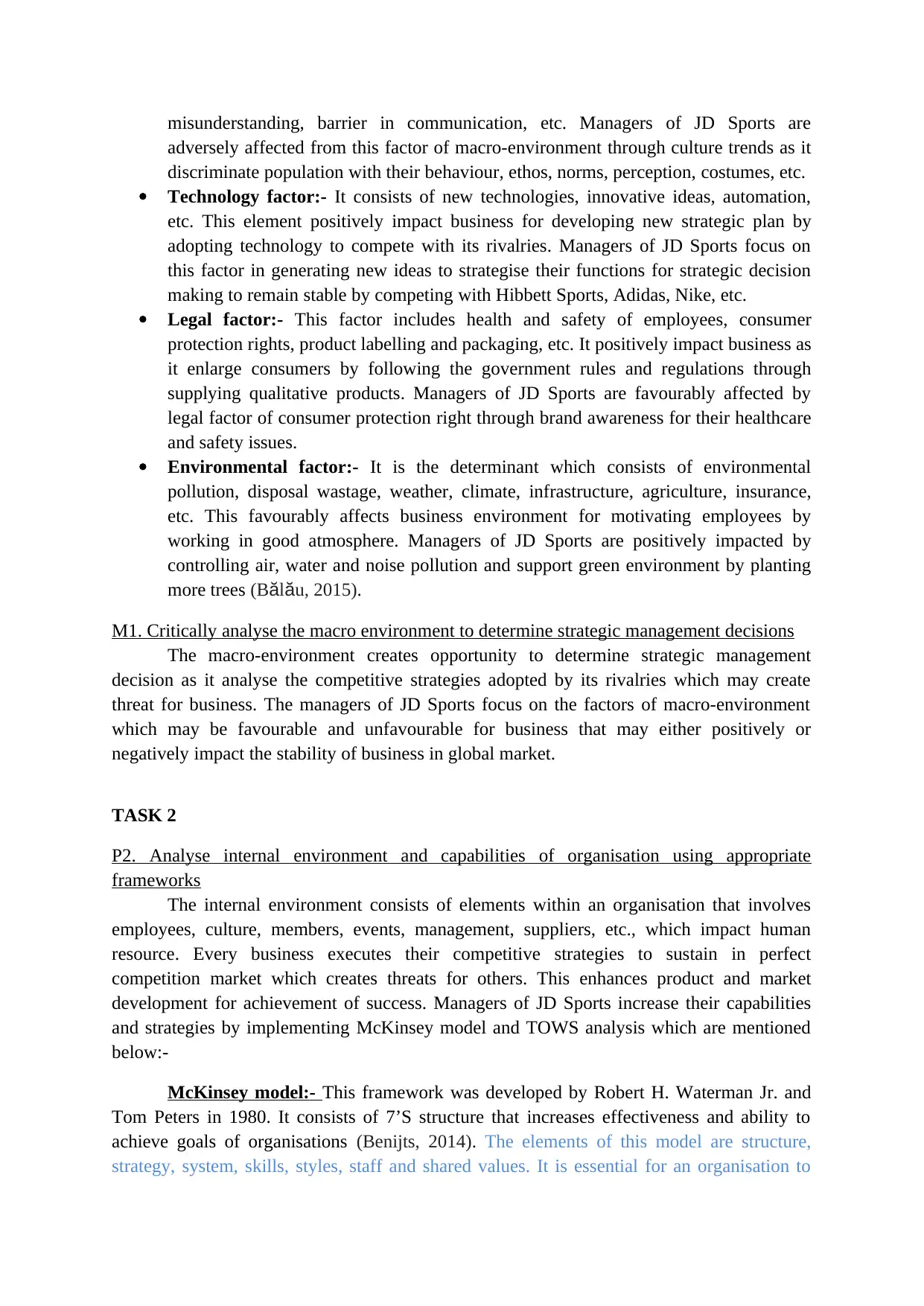
misunderstanding, barrier in communication, etc. Managers of JD Sports are
adversely affected from this factor of macro-environment through culture trends as it
discriminate population with their behaviour, ethos, norms, perception, costumes, etc.
Technology factor:- It consists of new technologies, innovative ideas, automation,
etc. This element positively impact business for developing new strategic plan by
adopting technology to compete with its rivalries. Managers of JD Sports focus on
this factor in generating new ideas to strategise their functions for strategic decision
making to remain stable by competing with Hibbett Sports, Adidas, Nike, etc.
Legal factor:- This factor includes health and safety of employees, consumer
protection rights, product labelling and packaging, etc. It positively impact business as
it enlarge consumers by following the government rules and regulations through
supplying qualitative products. Managers of JD Sports are favourably affected by
legal factor of consumer protection right through brand awareness for their healthcare
and safety issues.
Environmental factor:- It is the determinant which consists of environmental
pollution, disposal wastage, weather, climate, infrastructure, agriculture, insurance,
etc. This favourably affects business environment for motivating employees by
working in good atmosphere. Managers of JD Sports are positively impacted by
controlling air, water and noise pollution and support green environment by planting
more trees (Bălău, 2015).
M1. Critically analyse the macro environment to determine strategic management decisions
The macro-environment creates opportunity to determine strategic management
decision as it analyse the competitive strategies adopted by its rivalries which may create
threat for business. The managers of JD Sports focus on the factors of macro-environment
which may be favourable and unfavourable for business that may either positively or
negatively impact the stability of business in global market.
TASK 2
P2. Analyse internal environment and capabilities of organisation using appropriate
frameworks
The internal environment consists of elements within an organisation that involves
employees, culture, members, events, management, suppliers, etc., which impact human
resource. Every business executes their competitive strategies to sustain in perfect
competition market which creates threats for others. This enhances product and market
development for achievement of success. Managers of JD Sports increase their capabilities
and strategies by implementing McKinsey model and TOWS analysis which are mentioned
below:-
McKinsey model:- This framework was developed by Robert H. Waterman Jr. and
Tom Peters in 1980. It consists of 7’S structure that increases effectiveness and ability to
achieve goals of organisations (Benijts, 2014). The elements of this model are structure,
strategy, system, skills, styles, staff and shared values. It is essential for an organisation to
adversely affected from this factor of macro-environment through culture trends as it
discriminate population with their behaviour, ethos, norms, perception, costumes, etc.
Technology factor:- It consists of new technologies, innovative ideas, automation,
etc. This element positively impact business for developing new strategic plan by
adopting technology to compete with its rivalries. Managers of JD Sports focus on
this factor in generating new ideas to strategise their functions for strategic decision
making to remain stable by competing with Hibbett Sports, Adidas, Nike, etc.
Legal factor:- This factor includes health and safety of employees, consumer
protection rights, product labelling and packaging, etc. It positively impact business as
it enlarge consumers by following the government rules and regulations through
supplying qualitative products. Managers of JD Sports are favourably affected by
legal factor of consumer protection right through brand awareness for their healthcare
and safety issues.
Environmental factor:- It is the determinant which consists of environmental
pollution, disposal wastage, weather, climate, infrastructure, agriculture, insurance,
etc. This favourably affects business environment for motivating employees by
working in good atmosphere. Managers of JD Sports are positively impacted by
controlling air, water and noise pollution and support green environment by planting
more trees (Bălău, 2015).
M1. Critically analyse the macro environment to determine strategic management decisions
The macro-environment creates opportunity to determine strategic management
decision as it analyse the competitive strategies adopted by its rivalries which may create
threat for business. The managers of JD Sports focus on the factors of macro-environment
which may be favourable and unfavourable for business that may either positively or
negatively impact the stability of business in global market.
TASK 2
P2. Analyse internal environment and capabilities of organisation using appropriate
frameworks
The internal environment consists of elements within an organisation that involves
employees, culture, members, events, management, suppliers, etc., which impact human
resource. Every business executes their competitive strategies to sustain in perfect
competition market which creates threats for others. This enhances product and market
development for achievement of success. Managers of JD Sports increase their capabilities
and strategies by implementing McKinsey model and TOWS analysis which are mentioned
below:-
McKinsey model:- This framework was developed by Robert H. Waterman Jr. and
Tom Peters in 1980. It consists of 7’S structure that increases effectiveness and ability to
achieve goals of organisations (Benijts, 2014). The elements of this model are structure,
strategy, system, skills, styles, staff and shared values. It is essential for an organisation to
Paraphrase This Document
Need a fresh take? Get an instant paraphrase of this document with our AI Paraphraser
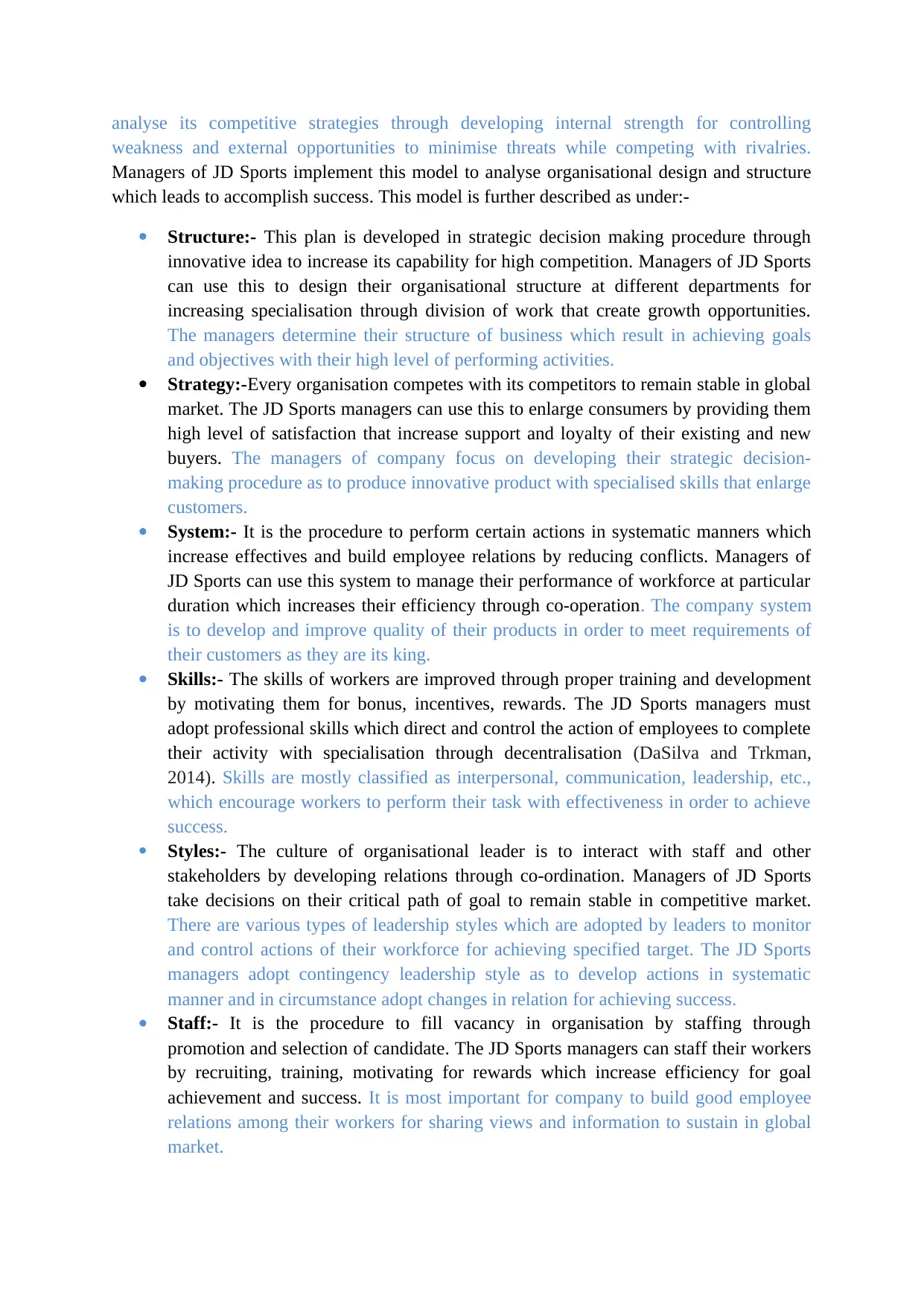
analyse its competitive strategies through developing internal strength for controlling
weakness and external opportunities to minimise threats while competing with rivalries.
Managers of JD Sports implement this model to analyse organisational design and structure
which leads to accomplish success. This model is further described as under:-
Structure:- This plan is developed in strategic decision making procedure through
innovative idea to increase its capability for high competition. Managers of JD Sports
can use this to design their organisational structure at different departments for
increasing specialisation through division of work that create growth opportunities.
The managers determine their structure of business which result in achieving goals
and objectives with their high level of performing activities.
Strategy:-Every organisation competes with its competitors to remain stable in global
market. The JD Sports managers can use this to enlarge consumers by providing them
high level of satisfaction that increase support and loyalty of their existing and new
buyers. The managers of company focus on developing their strategic decision-
making procedure as to produce innovative product with specialised skills that enlarge
customers.
System:- It is the procedure to perform certain actions in systematic manners which
increase effectives and build employee relations by reducing conflicts. Managers of
JD Sports can use this system to manage their performance of workforce at particular
duration which increases their efficiency through co-operation. The company system
is to develop and improve quality of their products in order to meet requirements of
their customers as they are its king.
Skills:- The skills of workers are improved through proper training and development
by motivating them for bonus, incentives, rewards. The JD Sports managers must
adopt professional skills which direct and control the action of employees to complete
their activity with specialisation through decentralisation (DaSilva and Trkman,
2014). Skills are mostly classified as interpersonal, communication, leadership, etc.,
which encourage workers to perform their task with effectiveness in order to achieve
success.
Styles:- The culture of organisational leader is to interact with staff and other
stakeholders by developing relations through co-ordination. Managers of JD Sports
take decisions on their critical path of goal to remain stable in competitive market.
There are various types of leadership styles which are adopted by leaders to monitor
and control actions of their workforce for achieving specified target. The JD Sports
managers adopt contingency leadership style as to develop actions in systematic
manner and in circumstance adopt changes in relation for achieving success.
Staff:- It is the procedure to fill vacancy in organisation by staffing through
promotion and selection of candidate. The JD Sports managers can staff their workers
by recruiting, training, motivating for rewards which increase efficiency for goal
achievement and success. It is most important for company to build good employee
relations among their workers for sharing views and information to sustain in global
market.
weakness and external opportunities to minimise threats while competing with rivalries.
Managers of JD Sports implement this model to analyse organisational design and structure
which leads to accomplish success. This model is further described as under:-
Structure:- This plan is developed in strategic decision making procedure through
innovative idea to increase its capability for high competition. Managers of JD Sports
can use this to design their organisational structure at different departments for
increasing specialisation through division of work that create growth opportunities.
The managers determine their structure of business which result in achieving goals
and objectives with their high level of performing activities.
Strategy:-Every organisation competes with its competitors to remain stable in global
market. The JD Sports managers can use this to enlarge consumers by providing them
high level of satisfaction that increase support and loyalty of their existing and new
buyers. The managers of company focus on developing their strategic decision-
making procedure as to produce innovative product with specialised skills that enlarge
customers.
System:- It is the procedure to perform certain actions in systematic manners which
increase effectives and build employee relations by reducing conflicts. Managers of
JD Sports can use this system to manage their performance of workforce at particular
duration which increases their efficiency through co-operation. The company system
is to develop and improve quality of their products in order to meet requirements of
their customers as they are its king.
Skills:- The skills of workers are improved through proper training and development
by motivating them for bonus, incentives, rewards. The JD Sports managers must
adopt professional skills which direct and control the action of employees to complete
their activity with specialisation through decentralisation (DaSilva and Trkman,
2014). Skills are mostly classified as interpersonal, communication, leadership, etc.,
which encourage workers to perform their task with effectiveness in order to achieve
success.
Styles:- The culture of organisational leader is to interact with staff and other
stakeholders by developing relations through co-ordination. Managers of JD Sports
take decisions on their critical path of goal to remain stable in competitive market.
There are various types of leadership styles which are adopted by leaders to monitor
and control actions of their workforce for achieving specified target. The JD Sports
managers adopt contingency leadership style as to develop actions in systematic
manner and in circumstance adopt changes in relation for achieving success.
Staff:- It is the procedure to fill vacancy in organisation by staffing through
promotion and selection of candidate. The JD Sports managers can staff their workers
by recruiting, training, motivating for rewards which increase efficiency for goal
achievement and success. It is most important for company to build good employee
relations among their workers for sharing views and information to sustain in global
market.
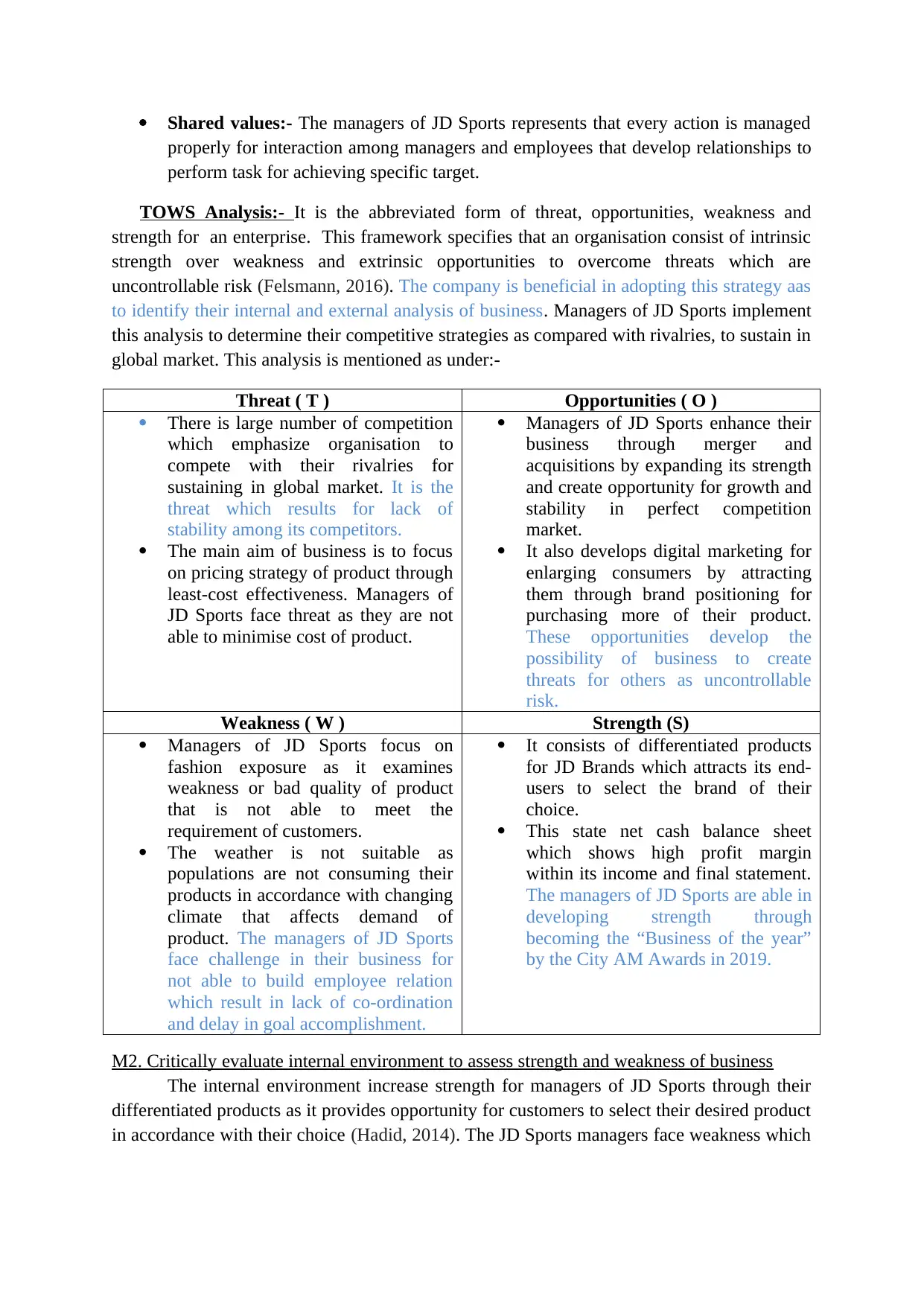
Shared values:- The managers of JD Sports represents that every action is managed
properly for interaction among managers and employees that develop relationships to
perform task for achieving specific target.
TOWS Analysis:- It is the abbreviated form of threat, opportunities, weakness and
strength for an enterprise. This framework specifies that an organisation consist of intrinsic
strength over weakness and extrinsic opportunities to overcome threats which are
uncontrollable risk (Felsmann, 2016). The company is beneficial in adopting this strategy aas
to identify their internal and external analysis of business. Managers of JD Sports implement
this analysis to determine their competitive strategies as compared with rivalries, to sustain in
global market. This analysis is mentioned as under:-
Threat ( T ) Opportunities ( O )
There is large number of competition
which emphasize organisation to
compete with their rivalries for
sustaining in global market. It is the
threat which results for lack of
stability among its competitors.
The main aim of business is to focus
on pricing strategy of product through
least-cost effectiveness. Managers of
JD Sports face threat as they are not
able to minimise cost of product.
Managers of JD Sports enhance their
business through merger and
acquisitions by expanding its strength
and create opportunity for growth and
stability in perfect competition
market.
It also develops digital marketing for
enlarging consumers by attracting
them through brand positioning for
purchasing more of their product.
These opportunities develop the
possibility of business to create
threats for others as uncontrollable
risk.
Weakness ( W ) Strength (S)
Managers of JD Sports focus on
fashion exposure as it examines
weakness or bad quality of product
that is not able to meet the
requirement of customers.
The weather is not suitable as
populations are not consuming their
products in accordance with changing
climate that affects demand of
product. The managers of JD Sports
face challenge in their business for
not able to build employee relation
which result in lack of co-ordination
and delay in goal accomplishment.
It consists of differentiated products
for JD Brands which attracts its end-
users to select the brand of their
choice.
This state net cash balance sheet
which shows high profit margin
within its income and final statement.
The managers of JD Sports are able in
developing strength through
becoming the “Business of the year”
by the City AM Awards in 2019.
M2. Critically evaluate internal environment to assess strength and weakness of business
The internal environment increase strength for managers of JD Sports through their
differentiated products as it provides opportunity for customers to select their desired product
in accordance with their choice (Hadid, 2014). The JD Sports managers face weakness which
properly for interaction among managers and employees that develop relationships to
perform task for achieving specific target.
TOWS Analysis:- It is the abbreviated form of threat, opportunities, weakness and
strength for an enterprise. This framework specifies that an organisation consist of intrinsic
strength over weakness and extrinsic opportunities to overcome threats which are
uncontrollable risk (Felsmann, 2016). The company is beneficial in adopting this strategy aas
to identify their internal and external analysis of business. Managers of JD Sports implement
this analysis to determine their competitive strategies as compared with rivalries, to sustain in
global market. This analysis is mentioned as under:-
Threat ( T ) Opportunities ( O )
There is large number of competition
which emphasize organisation to
compete with their rivalries for
sustaining in global market. It is the
threat which results for lack of
stability among its competitors.
The main aim of business is to focus
on pricing strategy of product through
least-cost effectiveness. Managers of
JD Sports face threat as they are not
able to minimise cost of product.
Managers of JD Sports enhance their
business through merger and
acquisitions by expanding its strength
and create opportunity for growth and
stability in perfect competition
market.
It also develops digital marketing for
enlarging consumers by attracting
them through brand positioning for
purchasing more of their product.
These opportunities develop the
possibility of business to create
threats for others as uncontrollable
risk.
Weakness ( W ) Strength (S)
Managers of JD Sports focus on
fashion exposure as it examines
weakness or bad quality of product
that is not able to meet the
requirement of customers.
The weather is not suitable as
populations are not consuming their
products in accordance with changing
climate that affects demand of
product. The managers of JD Sports
face challenge in their business for
not able to build employee relation
which result in lack of co-ordination
and delay in goal accomplishment.
It consists of differentiated products
for JD Brands which attracts its end-
users to select the brand of their
choice.
This state net cash balance sheet
which shows high profit margin
within its income and final statement.
The managers of JD Sports are able in
developing strength through
becoming the “Business of the year”
by the City AM Awards in 2019.
M2. Critically evaluate internal environment to assess strength and weakness of business
The internal environment increase strength for managers of JD Sports through their
differentiated products as it provides opportunity for customers to select their desired product
in accordance with their choice (Hadid, 2014). The JD Sports managers face weakness which
⊘ This is a preview!⊘
Do you want full access?
Subscribe today to unlock all pages.

Trusted by 1+ million students worldwide
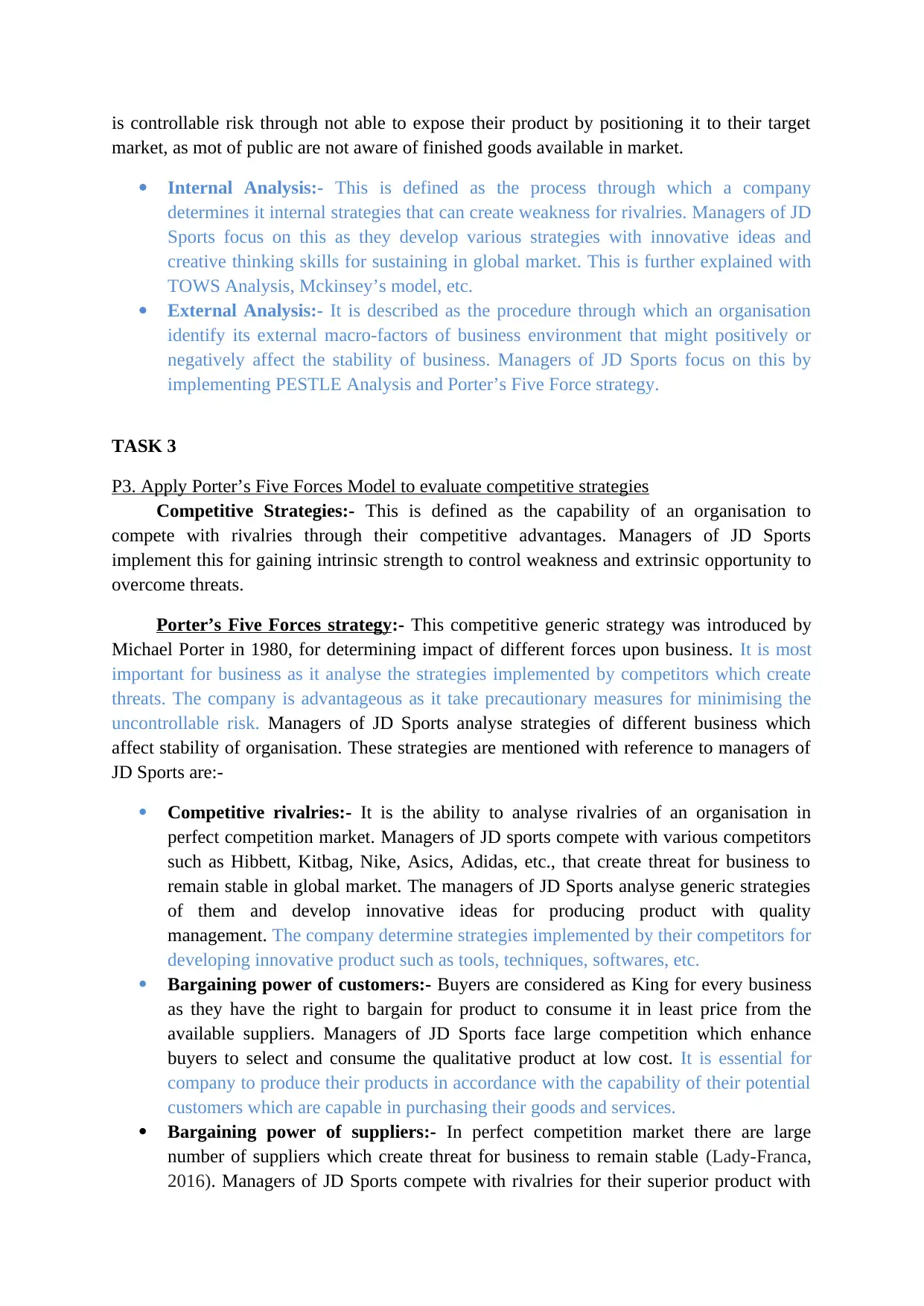
is controllable risk through not able to expose their product by positioning it to their target
market, as mot of public are not aware of finished goods available in market.
Internal Analysis:- This is defined as the process through which a company
determines it internal strategies that can create weakness for rivalries. Managers of JD
Sports focus on this as they develop various strategies with innovative ideas and
creative thinking skills for sustaining in global market. This is further explained with
TOWS Analysis, Mckinsey’s model, etc.
External Analysis:- It is described as the procedure through which an organisation
identify its external macro-factors of business environment that might positively or
negatively affect the stability of business. Managers of JD Sports focus on this by
implementing PESTLE Analysis and Porter’s Five Force strategy.
TASK 3
P3. Apply Porter’s Five Forces Model to evaluate competitive strategies
Competitive Strategies:- This is defined as the capability of an organisation to
compete with rivalries through their competitive advantages. Managers of JD Sports
implement this for gaining intrinsic strength to control weakness and extrinsic opportunity to
overcome threats.
Porter’s Five Forces strategy:- This competitive generic strategy was introduced by
Michael Porter in 1980, for determining impact of different forces upon business. It is most
important for business as it analyse the strategies implemented by competitors which create
threats. The company is advantageous as it take precautionary measures for minimising the
uncontrollable risk. Managers of JD Sports analyse strategies of different business which
affect stability of organisation. These strategies are mentioned with reference to managers of
JD Sports are:-
Competitive rivalries:- It is the ability to analyse rivalries of an organisation in
perfect competition market. Managers of JD sports compete with various competitors
such as Hibbett, Kitbag, Nike, Asics, Adidas, etc., that create threat for business to
remain stable in global market. The managers of JD Sports analyse generic strategies
of them and develop innovative ideas for producing product with quality
management. The company determine strategies implemented by their competitors for
developing innovative product such as tools, techniques, softwares, etc.
Bargaining power of customers:- Buyers are considered as King for every business
as they have the right to bargain for product to consume it in least price from the
available suppliers. Managers of JD Sports face large competition which enhance
buyers to select and consume the qualitative product at low cost. It is essential for
company to produce their products in accordance with the capability of their potential
customers which are capable in purchasing their goods and services.
Bargaining power of suppliers:- In perfect competition market there are large
number of suppliers which create threat for business to remain stable (Lady-Franca,
2016). Managers of JD Sports compete with rivalries for their superior product with
market, as mot of public are not aware of finished goods available in market.
Internal Analysis:- This is defined as the process through which a company
determines it internal strategies that can create weakness for rivalries. Managers of JD
Sports focus on this as they develop various strategies with innovative ideas and
creative thinking skills for sustaining in global market. This is further explained with
TOWS Analysis, Mckinsey’s model, etc.
External Analysis:- It is described as the procedure through which an organisation
identify its external macro-factors of business environment that might positively or
negatively affect the stability of business. Managers of JD Sports focus on this by
implementing PESTLE Analysis and Porter’s Five Force strategy.
TASK 3
P3. Apply Porter’s Five Forces Model to evaluate competitive strategies
Competitive Strategies:- This is defined as the capability of an organisation to
compete with rivalries through their competitive advantages. Managers of JD Sports
implement this for gaining intrinsic strength to control weakness and extrinsic opportunity to
overcome threats.
Porter’s Five Forces strategy:- This competitive generic strategy was introduced by
Michael Porter in 1980, for determining impact of different forces upon business. It is most
important for business as it analyse the strategies implemented by competitors which create
threats. The company is advantageous as it take precautionary measures for minimising the
uncontrollable risk. Managers of JD Sports analyse strategies of different business which
affect stability of organisation. These strategies are mentioned with reference to managers of
JD Sports are:-
Competitive rivalries:- It is the ability to analyse rivalries of an organisation in
perfect competition market. Managers of JD sports compete with various competitors
such as Hibbett, Kitbag, Nike, Asics, Adidas, etc., that create threat for business to
remain stable in global market. The managers of JD Sports analyse generic strategies
of them and develop innovative ideas for producing product with quality
management. The company determine strategies implemented by their competitors for
developing innovative product such as tools, techniques, softwares, etc.
Bargaining power of customers:- Buyers are considered as King for every business
as they have the right to bargain for product to consume it in least price from the
available suppliers. Managers of JD Sports face large competition which enhance
buyers to select and consume the qualitative product at low cost. It is essential for
company to produce their products in accordance with the capability of their potential
customers which are capable in purchasing their goods and services.
Bargaining power of suppliers:- In perfect competition market there are large
number of suppliers which create threat for business to remain stable (Lady-Franca,
2016). Managers of JD Sports compete with rivalries for their superior product with
Paraphrase This Document
Need a fresh take? Get an instant paraphrase of this document with our AI Paraphraser
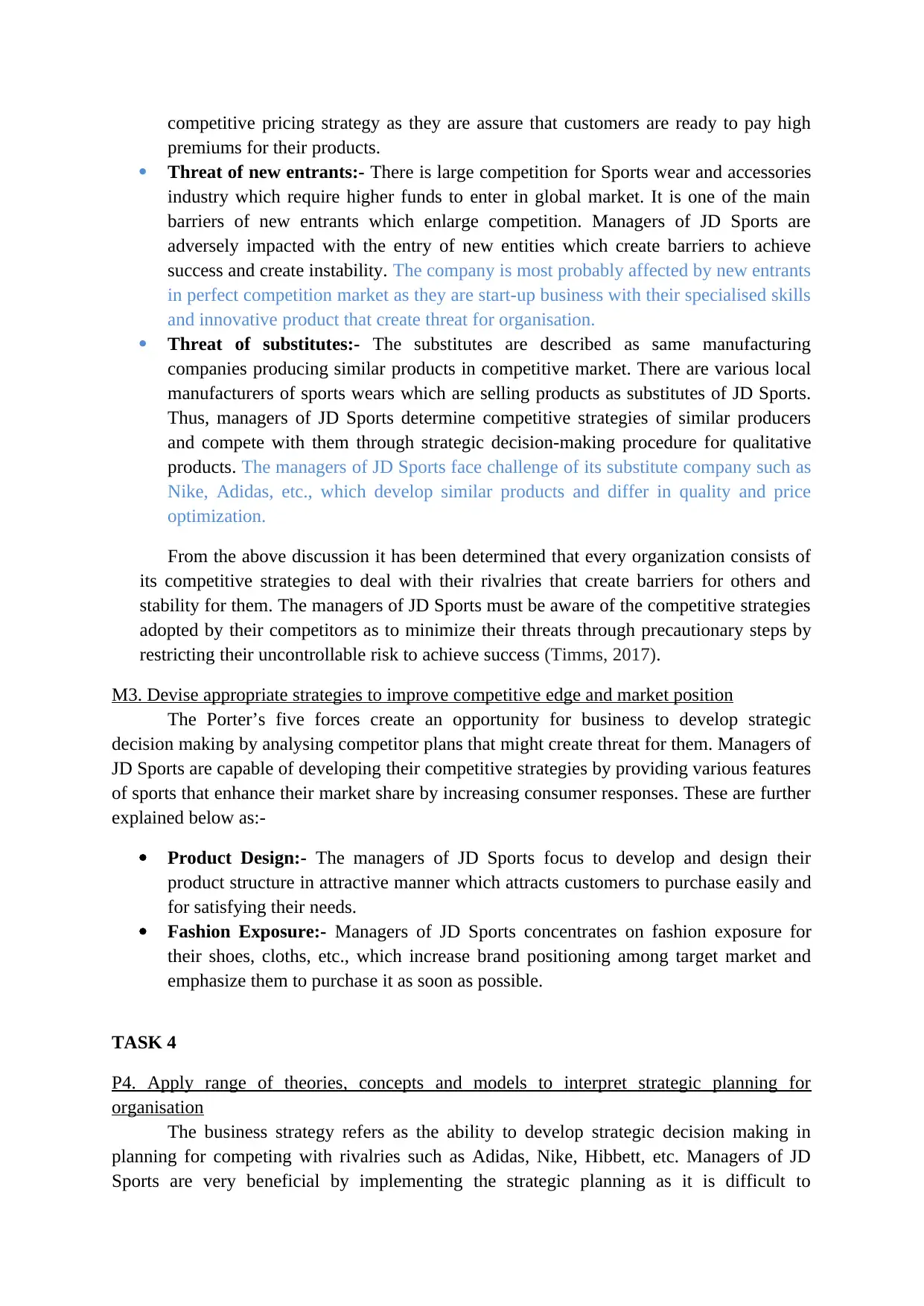
competitive pricing strategy as they are assure that customers are ready to pay high
premiums for their products.
Threat of new entrants:- There is large competition for Sports wear and accessories
industry which require higher funds to enter in global market. It is one of the main
barriers of new entrants which enlarge competition. Managers of JD Sports are
adversely impacted with the entry of new entities which create barriers to achieve
success and create instability. The company is most probably affected by new entrants
in perfect competition market as they are start-up business with their specialised skills
and innovative product that create threat for organisation.
Threat of substitutes:- The substitutes are described as same manufacturing
companies producing similar products in competitive market. There are various local
manufacturers of sports wears which are selling products as substitutes of JD Sports.
Thus, managers of JD Sports determine competitive strategies of similar producers
and compete with them through strategic decision-making procedure for qualitative
products. The managers of JD Sports face challenge of its substitute company such as
Nike, Adidas, etc., which develop similar products and differ in quality and price
optimization.
From the above discussion it has been determined that every organization consists of
its competitive strategies to deal with their rivalries that create barriers for others and
stability for them. The managers of JD Sports must be aware of the competitive strategies
adopted by their competitors as to minimize their threats through precautionary steps by
restricting their uncontrollable risk to achieve success (Timms, 2017).
M3. Devise appropriate strategies to improve competitive edge and market position
The Porter’s five forces create an opportunity for business to develop strategic
decision making by analysing competitor plans that might create threat for them. Managers of
JD Sports are capable of developing their competitive strategies by providing various features
of sports that enhance their market share by increasing consumer responses. These are further
explained below as:-
Product Design:- The managers of JD Sports focus to develop and design their
product structure in attractive manner which attracts customers to purchase easily and
for satisfying their needs.
Fashion Exposure:- Managers of JD Sports concentrates on fashion exposure for
their shoes, cloths, etc., which increase brand positioning among target market and
emphasize them to purchase it as soon as possible.
TASK 4
P4. Apply range of theories, concepts and models to interpret strategic planning for
organisation
The business strategy refers as the ability to develop strategic decision making in
planning for competing with rivalries such as Adidas, Nike, Hibbett, etc. Managers of JD
Sports are very beneficial by implementing the strategic planning as it is difficult to
premiums for their products.
Threat of new entrants:- There is large competition for Sports wear and accessories
industry which require higher funds to enter in global market. It is one of the main
barriers of new entrants which enlarge competition. Managers of JD Sports are
adversely impacted with the entry of new entities which create barriers to achieve
success and create instability. The company is most probably affected by new entrants
in perfect competition market as they are start-up business with their specialised skills
and innovative product that create threat for organisation.
Threat of substitutes:- The substitutes are described as same manufacturing
companies producing similar products in competitive market. There are various local
manufacturers of sports wears which are selling products as substitutes of JD Sports.
Thus, managers of JD Sports determine competitive strategies of similar producers
and compete with them through strategic decision-making procedure for qualitative
products. The managers of JD Sports face challenge of its substitute company such as
Nike, Adidas, etc., which develop similar products and differ in quality and price
optimization.
From the above discussion it has been determined that every organization consists of
its competitive strategies to deal with their rivalries that create barriers for others and
stability for them. The managers of JD Sports must be aware of the competitive strategies
adopted by their competitors as to minimize their threats through precautionary steps by
restricting their uncontrollable risk to achieve success (Timms, 2017).
M3. Devise appropriate strategies to improve competitive edge and market position
The Porter’s five forces create an opportunity for business to develop strategic
decision making by analysing competitor plans that might create threat for them. Managers of
JD Sports are capable of developing their competitive strategies by providing various features
of sports that enhance their market share by increasing consumer responses. These are further
explained below as:-
Product Design:- The managers of JD Sports focus to develop and design their
product structure in attractive manner which attracts customers to purchase easily and
for satisfying their needs.
Fashion Exposure:- Managers of JD Sports concentrates on fashion exposure for
their shoes, cloths, etc., which increase brand positioning among target market and
emphasize them to purchase it as soon as possible.
TASK 4
P4. Apply range of theories, concepts and models to interpret strategic planning for
organisation
The business strategy refers as the ability to develop strategic decision making in
planning for competing with rivalries such as Adidas, Nike, Hibbett, etc. Managers of JD
Sports are very beneficial by implementing the strategic planning as it is difficult to
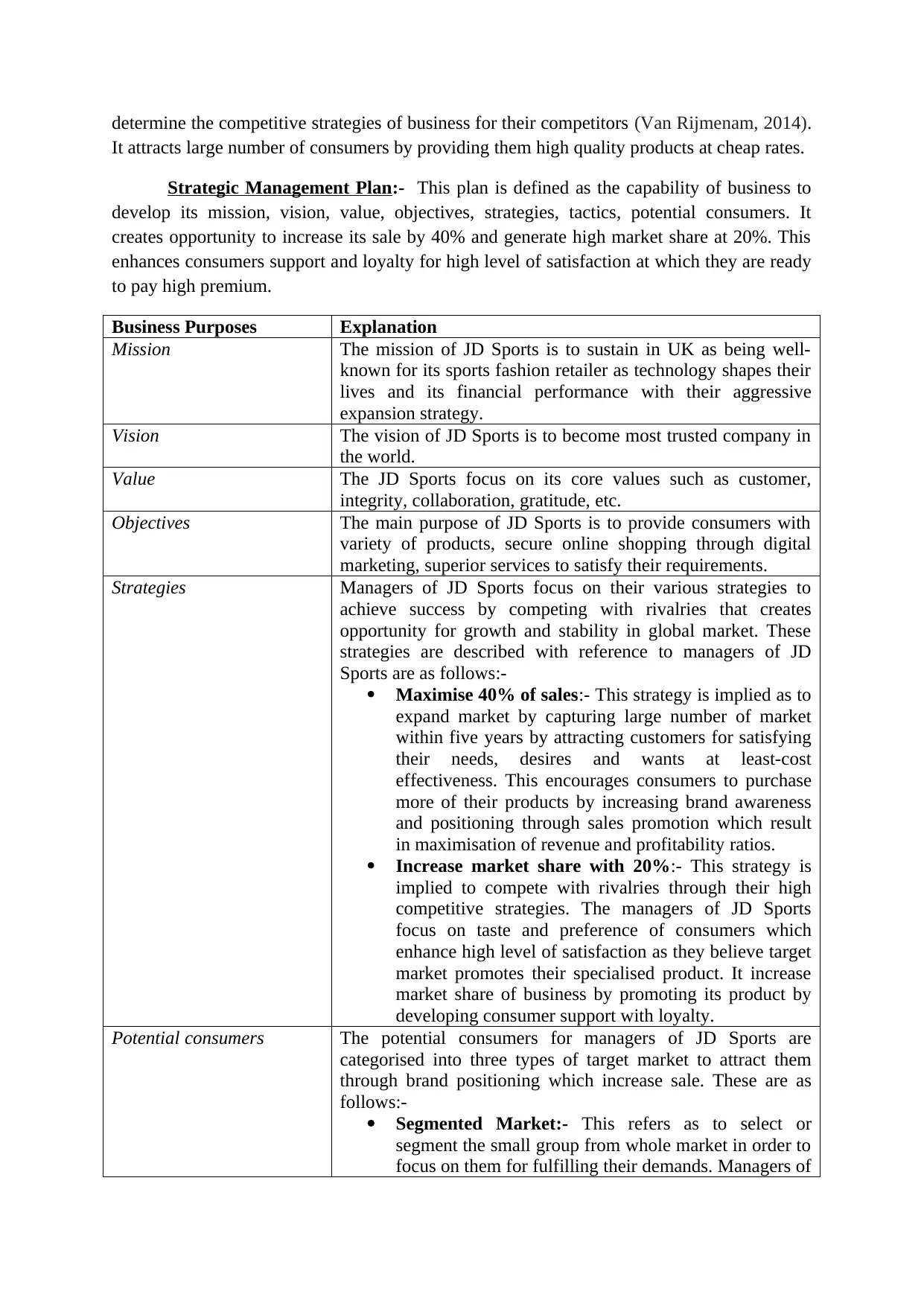
determine the competitive strategies of business for their competitors (Van Rijmenam, 2014).
It attracts large number of consumers by providing them high quality products at cheap rates.
Strategic Management Plan:- This plan is defined as the capability of business to
develop its mission, vision, value, objectives, strategies, tactics, potential consumers. It
creates opportunity to increase its sale by 40% and generate high market share at 20%. This
enhances consumers support and loyalty for high level of satisfaction at which they are ready
to pay high premium.
Business Purposes Explanation
Mission The mission of JD Sports is to sustain in UK as being well-
known for its sports fashion retailer as technology shapes their
lives and its financial performance with their aggressive
expansion strategy.
Vision The vision of JD Sports is to become most trusted company in
the world.
Value The JD Sports focus on its core values such as customer,
integrity, collaboration, gratitude, etc.
Objectives The main purpose of JD Sports is to provide consumers with
variety of products, secure online shopping through digital
marketing, superior services to satisfy their requirements.
Strategies Managers of JD Sports focus on their various strategies to
achieve success by competing with rivalries that creates
opportunity for growth and stability in global market. These
strategies are described with reference to managers of JD
Sports are as follows:-
Maximise 40% of sales:- This strategy is implied as to
expand market by capturing large number of market
within five years by attracting customers for satisfying
their needs, desires and wants at least-cost
effectiveness. This encourages consumers to purchase
more of their products by increasing brand awareness
and positioning through sales promotion which result
in maximisation of revenue and profitability ratios.
Increase market share with 20%:- This strategy is
implied to compete with rivalries through their high
competitive strategies. The managers of JD Sports
focus on taste and preference of consumers which
enhance high level of satisfaction as they believe target
market promotes their specialised product. It increase
market share of business by promoting its product by
developing consumer support with loyalty.
Potential consumers The potential consumers for managers of JD Sports are
categorised into three types of target market to attract them
through brand positioning which increase sale. These are as
follows:-
Segmented Market:- This refers as to select or
segment the small group from whole market in order to
focus on them for fulfilling their demands. Managers of
It attracts large number of consumers by providing them high quality products at cheap rates.
Strategic Management Plan:- This plan is defined as the capability of business to
develop its mission, vision, value, objectives, strategies, tactics, potential consumers. It
creates opportunity to increase its sale by 40% and generate high market share at 20%. This
enhances consumers support and loyalty for high level of satisfaction at which they are ready
to pay high premium.
Business Purposes Explanation
Mission The mission of JD Sports is to sustain in UK as being well-
known for its sports fashion retailer as technology shapes their
lives and its financial performance with their aggressive
expansion strategy.
Vision The vision of JD Sports is to become most trusted company in
the world.
Value The JD Sports focus on its core values such as customer,
integrity, collaboration, gratitude, etc.
Objectives The main purpose of JD Sports is to provide consumers with
variety of products, secure online shopping through digital
marketing, superior services to satisfy their requirements.
Strategies Managers of JD Sports focus on their various strategies to
achieve success by competing with rivalries that creates
opportunity for growth and stability in global market. These
strategies are described with reference to managers of JD
Sports are as follows:-
Maximise 40% of sales:- This strategy is implied as to
expand market by capturing large number of market
within five years by attracting customers for satisfying
their needs, desires and wants at least-cost
effectiveness. This encourages consumers to purchase
more of their products by increasing brand awareness
and positioning through sales promotion which result
in maximisation of revenue and profitability ratios.
Increase market share with 20%:- This strategy is
implied to compete with rivalries through their high
competitive strategies. The managers of JD Sports
focus on taste and preference of consumers which
enhance high level of satisfaction as they believe target
market promotes their specialised product. It increase
market share of business by promoting its product by
developing consumer support with loyalty.
Potential consumers The potential consumers for managers of JD Sports are
categorised into three types of target market to attract them
through brand positioning which increase sale. These are as
follows:-
Segmented Market:- This refers as to select or
segment the small group from whole market in order to
focus on them for fulfilling their demands. Managers of
⊘ This is a preview!⊘
Do you want full access?
Subscribe today to unlock all pages.

Trusted by 1+ million students worldwide
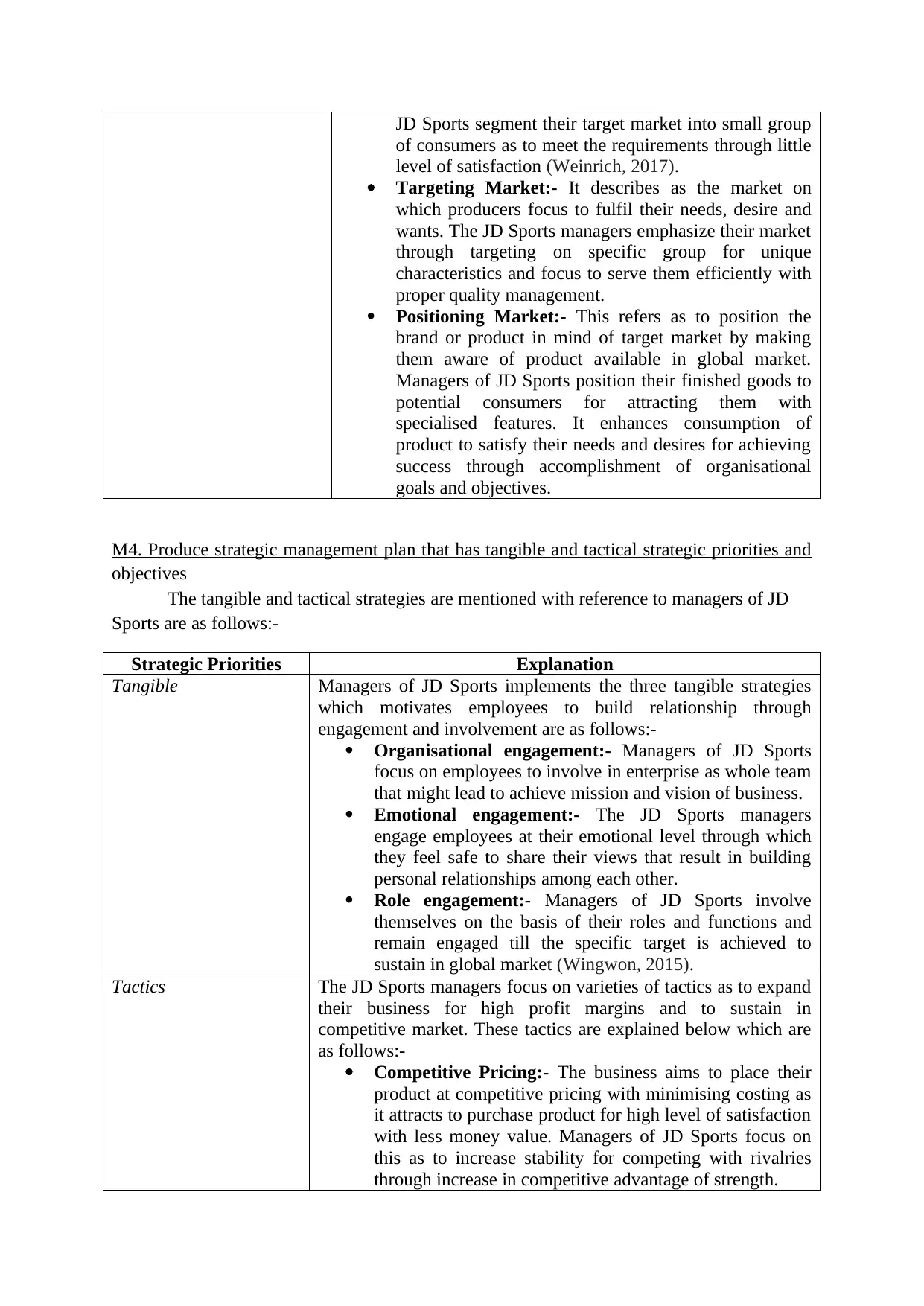
JD Sports segment their target market into small group
of consumers as to meet the requirements through little
level of satisfaction (Weinrich, 2017).
Targeting Market:- It describes as the market on
which producers focus to fulfil their needs, desire and
wants. The JD Sports managers emphasize their market
through targeting on specific group for unique
characteristics and focus to serve them efficiently with
proper quality management.
Positioning Market:- This refers as to position the
brand or product in mind of target market by making
them aware of product available in global market.
Managers of JD Sports position their finished goods to
potential consumers for attracting them with
specialised features. It enhances consumption of
product to satisfy their needs and desires for achieving
success through accomplishment of organisational
goals and objectives.
M4. Produce strategic management plan that has tangible and tactical strategic priorities and
objectives
The tangible and tactical strategies are mentioned with reference to managers of JD
Sports are as follows:-
Strategic Priorities Explanation
Tangible Managers of JD Sports implements the three tangible strategies
which motivates employees to build relationship through
engagement and involvement are as follows:-
Organisational engagement:- Managers of JD Sports
focus on employees to involve in enterprise as whole team
that might lead to achieve mission and vision of business.
Emotional engagement:- The JD Sports managers
engage employees at their emotional level through which
they feel safe to share their views that result in building
personal relationships among each other.
Role engagement:- Managers of JD Sports involve
themselves on the basis of their roles and functions and
remain engaged till the specific target is achieved to
sustain in global market (Wingwon, 2015).
Tactics The JD Sports managers focus on varieties of tactics as to expand
their business for high profit margins and to sustain in
competitive market. These tactics are explained below which are
as follows:-
Competitive Pricing:- The business aims to place their
product at competitive pricing with minimising costing as
it attracts to purchase product for high level of satisfaction
with less money value. Managers of JD Sports focus on
this as to increase stability for competing with rivalries
through increase in competitive advantage of strength.
of consumers as to meet the requirements through little
level of satisfaction (Weinrich, 2017).
Targeting Market:- It describes as the market on
which producers focus to fulfil their needs, desire and
wants. The JD Sports managers emphasize their market
through targeting on specific group for unique
characteristics and focus to serve them efficiently with
proper quality management.
Positioning Market:- This refers as to position the
brand or product in mind of target market by making
them aware of product available in global market.
Managers of JD Sports position their finished goods to
potential consumers for attracting them with
specialised features. It enhances consumption of
product to satisfy their needs and desires for achieving
success through accomplishment of organisational
goals and objectives.
M4. Produce strategic management plan that has tangible and tactical strategic priorities and
objectives
The tangible and tactical strategies are mentioned with reference to managers of JD
Sports are as follows:-
Strategic Priorities Explanation
Tangible Managers of JD Sports implements the three tangible strategies
which motivates employees to build relationship through
engagement and involvement are as follows:-
Organisational engagement:- Managers of JD Sports
focus on employees to involve in enterprise as whole team
that might lead to achieve mission and vision of business.
Emotional engagement:- The JD Sports managers
engage employees at their emotional level through which
they feel safe to share their views that result in building
personal relationships among each other.
Role engagement:- Managers of JD Sports involve
themselves on the basis of their roles and functions and
remain engaged till the specific target is achieved to
sustain in global market (Wingwon, 2015).
Tactics The JD Sports managers focus on varieties of tactics as to expand
their business for high profit margins and to sustain in
competitive market. These tactics are explained below which are
as follows:-
Competitive Pricing:- The business aims to place their
product at competitive pricing with minimising costing as
it attracts to purchase product for high level of satisfaction
with less money value. Managers of JD Sports focus on
this as to increase stability for competing with rivalries
through increase in competitive advantage of strength.
Paraphrase This Document
Need a fresh take? Get an instant paraphrase of this document with our AI Paraphraser
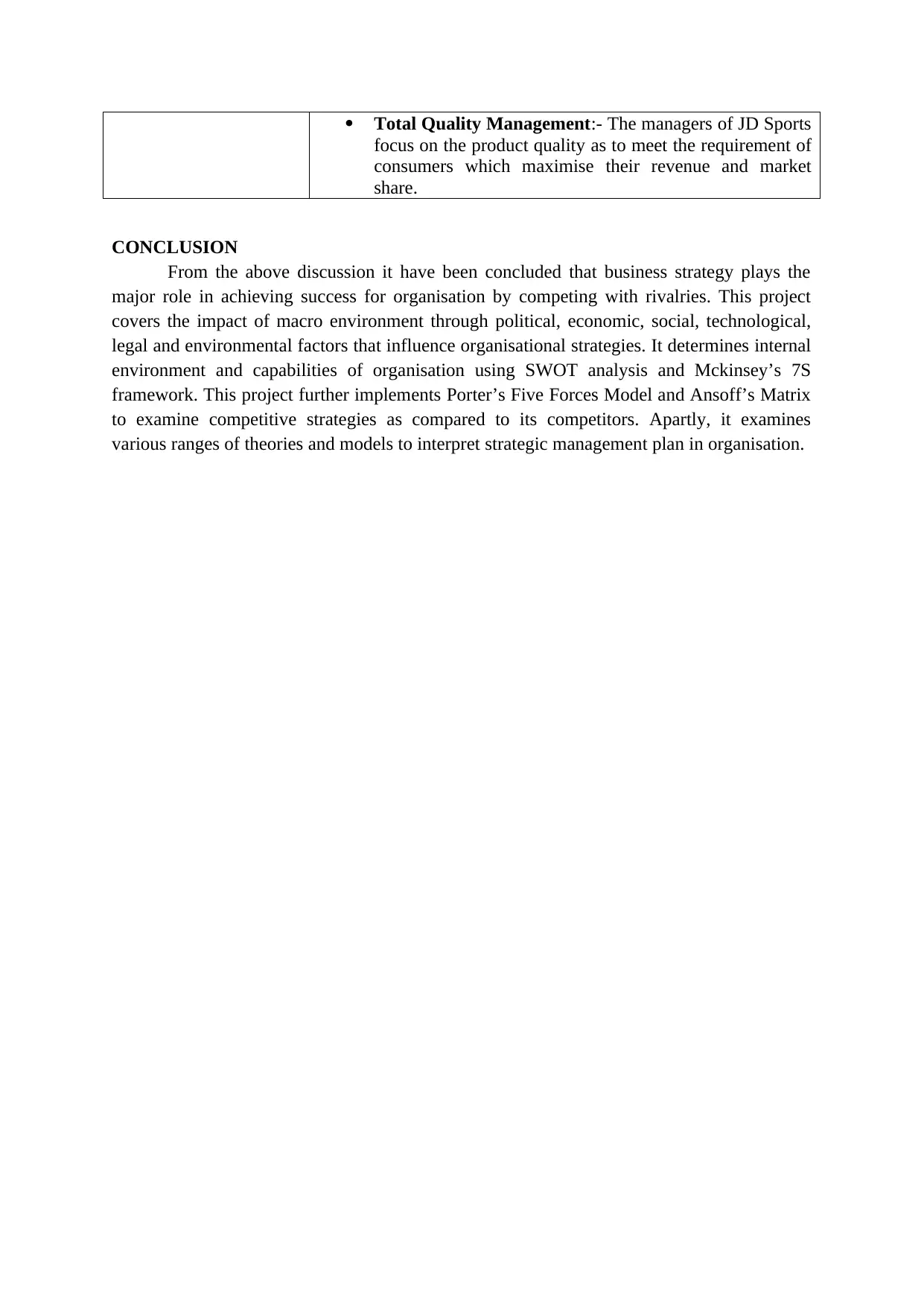
Total Quality Management:- The managers of JD Sports
focus on the product quality as to meet the requirement of
consumers which maximise their revenue and market
share.
CONCLUSION
From the above discussion it have been concluded that business strategy plays the
major role in achieving success for organisation by competing with rivalries. This project
covers the impact of macro environment through political, economic, social, technological,
legal and environmental factors that influence organisational strategies. It determines internal
environment and capabilities of organisation using SWOT analysis and Mckinsey’s 7S
framework. This project further implements Porter’s Five Forces Model and Ansoff’s Matrix
to examine competitive strategies as compared to its competitors. Apartly, it examines
various ranges of theories and models to interpret strategic management plan in organisation.
focus on the product quality as to meet the requirement of
consumers which maximise their revenue and market
share.
CONCLUSION
From the above discussion it have been concluded that business strategy plays the
major role in achieving success for organisation by competing with rivalries. This project
covers the impact of macro environment through political, economic, social, technological,
legal and environmental factors that influence organisational strategies. It determines internal
environment and capabilities of organisation using SWOT analysis and Mckinsey’s 7S
framework. This project further implements Porter’s Five Forces Model and Ansoff’s Matrix
to examine competitive strategies as compared to its competitors. Apartly, it examines
various ranges of theories and models to interpret strategic management plan in organisation.

REFERENCES
Books and journal
Agrawal, H. O., 2016. An Approach to Business Strategy. In Handbook of Research on
Promotional Strategies and Consumer Influence in the Service Sector. (pp. 154-182). IGI
Global.
Alstete, J. W., 2014. Strategy choices of potential entrepreneurs. Journal of Education for
Business. 89(2). pp.77-83.
Bălău, M., 2015. The influence of market context on business strategy, competitor imitation
and operational effectiveness. Acta Universitatis Danubius. Œconomica. 11(4). pp.33-40.
Benijts, T., 2014. A business sustainability model for government corporations. A Belgian
case study. Business Strategy and the Environment. 23(3). pp.204-216.
DaSilva, C. M. and Trkman, P., 2014. Business model: What it is and what it is not. Long
range planning. 47(6). pp.379-389.
Felsmann, B., 2016. Do institutions matter in business strategy?–The changing focus of
strategic management to institutions: a literature review. Vezetéstudomány-Budapest
Management Review. 47(5). pp.2-11.
Hadid, W., 2014. The relationship between lean service, activity-based costing and business
strategy and their impact on performance. (Doctoral dissertation, Brunel University Brunel
Business School PhD Theses).
Lady-Franca, O. C., 2016. Induction strategy of Igbo entrepreneurs and micro-business
success: A study of household equipment line, main market Onitsha, Nigeria. Acta
Universitatis Sapientiae, Economics and Business. 4(1). pp.43-65.
Timms, P., 2017. Transformational HR: How human resources can create value and impact
business strategy. Kogan Page Publishers.
Van Rijmenam, M., 2014. Think bigger: Developing a successful big data strategy for your
business. Amacom.
Weinrich, T., 2017. Reviewing organizational design components for digital business
strategy. BLED.
Wingwon, B., 2015. Effect of entrepreneurship, business strategy and business networking
toward competitive advantage of small and medium enterprises in Thailand. International
Journal of Entrepreneurship and Small Business. 26(2). pp.217-232.
Books and journal
Agrawal, H. O., 2016. An Approach to Business Strategy. In Handbook of Research on
Promotional Strategies and Consumer Influence in the Service Sector. (pp. 154-182). IGI
Global.
Alstete, J. W., 2014. Strategy choices of potential entrepreneurs. Journal of Education for
Business. 89(2). pp.77-83.
Bălău, M., 2015. The influence of market context on business strategy, competitor imitation
and operational effectiveness. Acta Universitatis Danubius. Œconomica. 11(4). pp.33-40.
Benijts, T., 2014. A business sustainability model for government corporations. A Belgian
case study. Business Strategy and the Environment. 23(3). pp.204-216.
DaSilva, C. M. and Trkman, P., 2014. Business model: What it is and what it is not. Long
range planning. 47(6). pp.379-389.
Felsmann, B., 2016. Do institutions matter in business strategy?–The changing focus of
strategic management to institutions: a literature review. Vezetéstudomány-Budapest
Management Review. 47(5). pp.2-11.
Hadid, W., 2014. The relationship between lean service, activity-based costing and business
strategy and their impact on performance. (Doctoral dissertation, Brunel University Brunel
Business School PhD Theses).
Lady-Franca, O. C., 2016. Induction strategy of Igbo entrepreneurs and micro-business
success: A study of household equipment line, main market Onitsha, Nigeria. Acta
Universitatis Sapientiae, Economics and Business. 4(1). pp.43-65.
Timms, P., 2017. Transformational HR: How human resources can create value and impact
business strategy. Kogan Page Publishers.
Van Rijmenam, M., 2014. Think bigger: Developing a successful big data strategy for your
business. Amacom.
Weinrich, T., 2017. Reviewing organizational design components for digital business
strategy. BLED.
Wingwon, B., 2015. Effect of entrepreneurship, business strategy and business networking
toward competitive advantage of small and medium enterprises in Thailand. International
Journal of Entrepreneurship and Small Business. 26(2). pp.217-232.
⊘ This is a preview!⊘
Do you want full access?
Subscribe today to unlock all pages.

Trusted by 1+ million students worldwide
1 out of 12
Related Documents
Your All-in-One AI-Powered Toolkit for Academic Success.
+13062052269
info@desklib.com
Available 24*7 on WhatsApp / Email
![[object Object]](/_next/static/media/star-bottom.7253800d.svg)
Unlock your academic potential
Copyright © 2020–2025 A2Z Services. All Rights Reserved. Developed and managed by ZUCOL.





